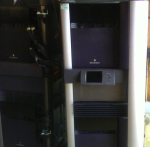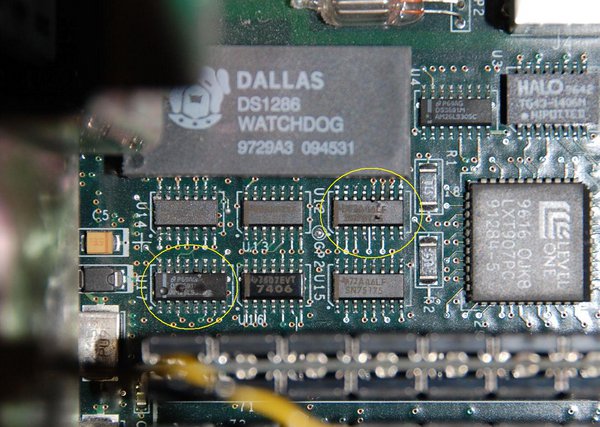I brought home a MIPS-based Cobalt Qube 2 I picked up at the local university surplus store today, and the first thing I did was try to connect it to my (already running) Indigo2 through its second serial port to monitor the Qube's console during boot. When I first tried to connect to the serial port on the Qube, there was a little spark. Recalling a similar recent event at work with an ungrounded embedded system's serial port, I figured that the Qube just wasn't grounded through its power supply and had floated to some unknown voltage and would be fine once the serial was connected.
Bad guess. To avoid the spark, I first unplugged the Qube's 12V input, plugged in the serial cable, then tried to plug in the Qube again. Right away, I hear a loud CRACK and the Indigo2 buzzes through its speakers and shuts off abruptly, the Qube's 12V plug is charred, and neither the Qube or the I2 would turn on anymore. Oh, crap.
To avoid the spark, I first unplugged the Qube's 12V input, plugged in the serial cable, then tried to plug in the Qube again. Right away, I hear a loud CRACK and the Indigo2 buzzes through its speakers and shuts off abruptly, the Qube's 12V plug is charred, and neither the Qube or the I2 would turn on anymore. Oh, crap.
I unplugged both and had dinner with the family. When I came back a half hour later, I plugged back in the I2 and it fired right up. I'm running full diagnostics now, and it seems fine, other than the second serial UART failing loopback. So that's damaged.
The Qube is dead, so I'm about to open it up and start checking it out. I'm an embedded systems EE, so I at least have a chance at repairing it, but this still sucks.
What the heck did I actually do? RS-232 is supposed to be shorts-tolerant (it's in the spec), so even if the pins were wrong it shouldn't bring down the two systems. I could see the Qube possibly not being fully compliant, but not the I2. Does the Qube have some funky serial port pinout that's totally nonstandard? I've used both of the I2's serial ports before without problems.
Do Indigo2 power supplies have resettable thermal and/or overcurrent protection? It seems like mine does. I couldn't find it in any documentation but I thought someone here might know for sure.
Also, does anyone know if the serial hardware on an IP28 is repairable, or am I down to only one serial port from now on with this CPU board? Here's where I hope to find a discrete serial UART chip, instead of it being embedded in an SGI ASIC.
Bad guess.
 To avoid the spark, I first unplugged the Qube's 12V input, plugged in the serial cable, then tried to plug in the Qube again. Right away, I hear a loud CRACK and the Indigo2 buzzes through its speakers and shuts off abruptly, the Qube's 12V plug is charred, and neither the Qube or the I2 would turn on anymore. Oh, crap.
To avoid the spark, I first unplugged the Qube's 12V input, plugged in the serial cable, then tried to plug in the Qube again. Right away, I hear a loud CRACK and the Indigo2 buzzes through its speakers and shuts off abruptly, the Qube's 12V plug is charred, and neither the Qube or the I2 would turn on anymore. Oh, crap.
I unplugged both and had dinner with the family. When I came back a half hour later, I plugged back in the I2 and it fired right up. I'm running full diagnostics now, and it seems fine, other than the second serial UART failing loopback. So that's damaged.

The Qube is dead, so I'm about to open it up and start checking it out. I'm an embedded systems EE, so I at least have a chance at repairing it, but this still sucks.
What the heck did I actually do? RS-232 is supposed to be shorts-tolerant (it's in the spec), so even if the pins were wrong it shouldn't bring down the two systems. I could see the Qube possibly not being fully compliant, but not the I2. Does the Qube have some funky serial port pinout that's totally nonstandard? I've used both of the I2's serial ports before without problems.
Do Indigo2 power supplies have resettable thermal and/or overcurrent protection? It seems like mine does. I couldn't find it in any documentation but I thought someone here might know for sure.
Also, does anyone know if the serial hardware on an IP28 is repairable, or am I down to only one serial port from now on with this CPU board? Here's where I hope to find a discrete serial UART chip, instead of it being embedded in an SGI ASIC.
_________________

 R10K Indigo2 MaxIMPACT, 4 TRAMS, 768MB RAM, 2x9GB HD, CD-ROM, Phobos G160
R10K Indigo2 MaxIMPACT, 4 TRAMS, 768MB RAM, 2x9GB HD, CD-ROM, Phobos G160
Black Cardinal








 <>
<>

 Seriously though, you have a good point.
Seriously though, you have a good point.







 <- MicroVAX 3500
<- MicroVAX 3500
 <- MicroVAX 3300
<- MicroVAX 3300

 I was very happy to find a MAX249 serial interface chip on board:
I was very happy to find a MAX249 serial interface chip on board:





